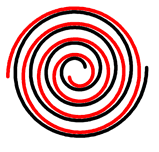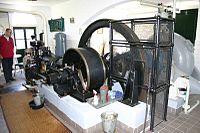Pump

A pump is a device used to move liquids or slurries. A pump moves liquids from lower pressure to higher pressure, and overcomes this difference in pressure by adding energy to the system (such as a water system). A gas pump is generally called a compressor, except in very low pressure-rise applications, such as in heating, ventilating, and air-conditioning, where the operative equipment consists of fans or blowers.
Pumps work by using mechanical forces to push the material, either by physically lifting, or by the force of compression.
The earliest type of pump was the Archimedes screw, described by Archimedes in the 3rd century BC, but used earlier by Sennacherib, King of Assyria, in the 7th century BC.[1] In the 13th century AD, al-Jazari described and illustrated different types of pumps, including reciprocating pumps, double acting pumps with suction pipes, water pumps, and pistons.[2][3]
Types

Pumps fall into two major groups: rotodynamic pumps and positive displacement pumps. Their names describe the method for moving a fluid. Rotodynamic pumps are based on bladed impellars which rotate within the fluid to impart a tangential acceleration to the fluid and a consequent increase in the energy of the fluid. The purpose of the pump is to convert this energy into pressure energy of the fluid to be used in the associated piping system.
Positive displacement pumps



A positive displacement pump causes a liquid to move by trapping a fixed amount of fluid and then forcing (displacing) that trapped volume into the discharge pipe. Positive displacement pumps can be further classified as either rotary-type (for example the rotary vane or lobe pumps similar to oil pumps used in car engines). Another common type is the Wendelkolben pump or the helical twisted Roots pump. The low pulsation rate and gentle performance of this Roots-type positive displacement pump is achieved due to a combination of its two 90° helical twisted rotors, and a triangular shaped sealing line configuration, both at the point of suction and at the point of discharge. This design produces a continuous and non-vorticuless flow with equal volume. High capacity industrial "air compressors" have been designed to employ this principle as well as most "supercharges" used on internal combustion engines.
Reciprocating-type pumps use a piston and cylinder arrangment with suction and discharge valves integrated into the pump. Pump arrangements are from "simplex" one cylinder to in some cases four (quad) or more but usually are "duplex" two or "triplex" 3 cylinder. Furthermore they are either "single acting" independant suction and discharge strokes or "double acting" suction and discharge in both directions. The pumps can be powered by air, steam or through a belt drive from an engine or motor. This type of pump was used extensively in the early days (1800's) of steam propulsion as boiler feed water pumps. Though still used today reciprocating pumps are typically used for pumping highly viscous fluids including concrete and heavy oils.
Another modern application of positive displacment pumps are diaphragm pumps commonly called "Sand Piper Pumps" and are used extensivley for dewatering and generally use compressed air as a motive source of energy.
Centrifugal Pumps
Centrifugal Pumps are rotodynamic pumps which convert Mechanical energy into Hydraulic energy by centripetal force on the liquid. Typically, a rotating impeller increases the velocity of the fluid. The casing, or volute, of the pump then acts to convert this increased velocity into an increase in pressure. So if the mechanical energy is converted into a pressure head by centripetal force, the pump is classified as centrifugal. Such pumps are found in virtually every industry, and in domestic service in developed countries for washing machines, dishwashers, swimming pools, and water supply.
A wide range of designs are available, with constant and variable speed drives. Horizontal shafts are the most common. Single-stage pumps are usual in the smaller ratings. Pumps with up to 11 stages are in service. A demanding duty is boiler feed, and today's designs are typically 3 - 4 stage, with speeds of up to 6000 r/min.
After motors, centrifugal pumps are arguably the most common machine, and they are a significant user of energy. Given design margins, it is not unusual for a pump to be found to be over-sized, having been selected poorly for its intended duty. Running a constant speed pump throttled causes energy waste. A condition monitoring test can detect this condition and help size a smaller impeller, either new, or by machining the initial one, to achieve great energy reduction.
Pumps also wear internally, at a rate varying with the liquid pumped, materials of construction and operating regime. Again, condition monitoring can be applied to detect and quantify the extent and rate of wear and also help decide when overhaul is justified on an energy-saving basis.
Kinetic Pumps
- Continuous energy addition
- Conversion of added energy to increase in kinetic energy (increase in velocity)
- Conversion increased velocity to increase in pressure
- Conversion of Kinetic head to Pressure Head.
- Meet all heads like Kinetic , Potential, and Pressure
Positive Displacement
- Periodic energy addition
- Added energy forces displacement of fluid in an enclosed volume
- Fluid displacement results in direct increase in pressure
Application

Pumps are used throughout society for a variety of purposes. Early applications includes the use of the windmill or watermill to pump water. Today, the pump is used for irrigation, water supply, gasoline supply, air conditioning systems, refrigeration (usually called a compressor), chemical movement, sewage movement, flood control, marine services, etc.
Because of the wide variety of applications, pumps have a plethora of shapes and sizes: from very large to very small, from handling gas to handling liquid, from high pressure to low pressure, and from high volume to low volume.
Pumps as public water supplies
One sort of pump once common was a hand-powered water pump over a water well or water main where people could work it to extract water, before most houses had individual water supplies.
From this came the expression "parish pump" for "the sort of matter chattered about by people when they meet when they go to get water", "matter of only local interest".
Power source

Pumps may be powered by an internal combustion engine, electric motor, manually (as with the hand pump used for pumping groundwater, called walking beam pump), or by wind power (common for irrigation). Solar power has been used to power an electric motor, for remote locations.[1]
See also

- Airlift pump
- Beam pump and walking beam pump
- Bicycle pump
- Boiler feedwater pump
- Breast pump
- Centrifugal pump
- Chain pumps
- Circulator pump
- Concrete pump
- Condensate pump
- Cyclic pump
- Diving pump
- Eductor-jet pump
- Electropump
- Fire pump and Jockey pump
- Gas compressors
- Gerotor
- Hand pump
- Hydraulic ram
- Metering pump
- Oil pump
- Peristaltic pump
- Progressive cavity pump (also known as; progressing cavity, eccentric screw or Mono pump)
- Pumping station
- Pumpjack (oil pump)
- Rope pump
- Roundabout PlayPump
- Tesla turbine
- Treadle pump
- Turbopump
- Vacuum pump
- Well water pump
- Wind pump
References
- ^ Stephanie Dalley and John Peter Oleson (January 2003). "Sennacherib, Archimedes, and the Water Screw: The Context of Invention in the Ancient World", Technology and Culture 44 (1).
- ^ Al-Jazari, The Book of Knowledge of Ingenious Mechanical Devices : Kitáb fí ma'rifat al-hiyal al-handasiyya, translated by P. Hill (1973). Springer.
- ^ Derek de Solla Price (1975). Review of Ibn al-Razzaz al-Jazari, The Book of Knowledge of Ingenious Mechanical Devices. Technology and Culture 16 (1), p. 81.
Further reading
- www.masterflopump.com - Comprehensive descriptions of different pump types
- www.lightmypump.com - Pump and pump system information
- Australian Pump Technical Handbook, 3rd edition, 1987, Australian Pump Manufacturers' Association Ltd
- Publications of Europump and the Hydraulic Institute
- Predicting maintenance of pumps using condition monitoring Ray Beebe, Elsevier, 2004
